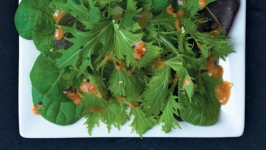Food for All
Sweet potatoes aren’t actually potatoes. They are part of the morning glory family, and are a heat-loving summer crop, not always suited for our short growing season and cooler climate. But the Ottawa Food Bank is setting out to change that notion, and at the same time, explore ways of building strong community bonds for its clients by growing, producing and offering locally grown fresh ethno-cultural foods.
On donated farmland just outside of Stittsville, Ont., Jason Gray, community harvest manager for the Ottawa Food Bank, and several hundred volunteers, tend to almost 11 acres — six and a half of which are edible nutrient-dense crops — to produce upwards of 165,000 pounds of “food bank crops” each year to disburse among 26 community food banks.
In Ottawa, more than 39,000 people visit emergency food bank programs every month, and 36 per cent of those they serve are children. In 2010, the Ottawa Food Bank introduced Community Harvest as an innovative pilot involving the production of organic carrots and potatoes, and has since evolved the program under the care and mentorship of Gray, yielding more than 21 varieties of produce and developing partnerships with more than 30 local agricultural enterprises to ensure that the most vulnerable among us are able to secure fresh, healthy food.
However, the Ottawa Food Bank recognized very quickly that each of the community food banks serves a unique population, reflective of the diversity of cultures within the National Capital Region. Indeed, according to one study, 25 per cent of participants accessing food banks in Ottawa were not born in Canada. Serving clients from Middle Eastern countries, East African and East Asian countries, as well as individuals and families from First Nations, Métis, Inuit and Afro-Caribbean communities, Gray and the Ottawa Food Bank set about to address the need for more accessibility to, and distribution of, ethnocultural foods for insecure households.
Over a period of one year, prior to the pandemic, the Ottawa Food Bank undertook a study called The Global Marketplace Pilot, through which it surveyed community food banks and member agencies to help identify gaps in the provision of ethnocultural foods, as well as foods that are more common across cultures that could be considered for addition to the Ottawa Food Bank food inventory.
“At the conclusion of the pilot, we collated all the feedback from clients and agencies,” explains Jill Burns, a registered dietitian with the Ottawa Food Bank, who works alongside Gray. “The survey revealed that the top food items our member agencies would like to request include: Halal meats, oil, canned fish, breads — pita and flatbreads — dates, and ethnocultural vegetables, such as plantain, okra, yams, cassava, ginger and garlic.
Following the pilot, the Ottawa Food Bank committed to ensuring community food banks each receive annual grants to further customize their purchasing decisions for their clients, while at the same time, committing to diversifying the culturally significant staples that are underserved in the Ottawa Food Bank inventory, and to continuing to diversify and expand upon the volume of ethnocultural vegetables grown at the farm.
Through trial and teamwork
In 2020, Gray and his team of volunteers planted roughly 6,500 cloves of music garlic, a robust variety, in response to the early feedback from the Global Marketplace Pilot. “From that planting, we yielded just over 1,500 pounds of high-quality bulbs,” Gray says. “That’s close to 300 pounds of garlic distributed as single cloves, and just under 200 pounds of garlic scapes.”
Due to client demand, they planted 50 per cent more garlic in October 2021, with hopes to continue that upward growth in the next planting season.
Gray, who grew up outside of Montreal, worked on neighbouring farms when he was young. His interest for sustainable farming and understanding the nuances of each farm ecosystem, led him to pursue post secondary education at McGill, where he received a degree in botany and plant biology, after which he went on to the University of British Columbia, where he received his bachelor of science in agroecology in 2004.
With a vision for farming as a tangible way to facilitate community capacity and build resilience through plants and food, along with the foundational work he does with his Ottawa Food Bank colleagues to develop community-led and community-based initiatives, his enthusiasm is palpable.
“We make every attempt to include the voice of the community in our planning,” he says. “In some ways, the pandemic has facilitated closer collaboration and the ability to strategically plan alongside agencies and food bank clients.”
Not only did the information supplied by member agencies and clients help Gray determine what crops they should grow at the farm, but the information has also been critical in helping him determine the relative volume of each crop required for each specific food bank and agency on a weekly, monthly and sometimes daily basis.
In addition to garlic, Gray has added okra and sweet potatoes to the farm and reintroduced both Asian and European eggplant to the crop mix. “Of these four crops, okra and sweet potatoes were the ones requiring the most research,” Gray explains. “Over the years, I have done a lot of research in the off-season, but I have also gained considerable practical knowledge by speaking to other farmers about their experiences with growing these crops. Sometimes it just takes a few adventurous and risk-taking farmers in the north to grow things that have not typically been grown here, and when successful, share their new knowledge with others.”
Learning from others
While not typically a crop cultivated in our more northern region, the Ottawa Food Bank is happy with the results of its first sweet potato trial in 2021. After testing several North American and Asian varieties, Gray determined that the commonly grown Covington variety, rich in beta-carotene and with its 110 to 120 days to mature, did the best under local growing conditions.
“Sweet potatoes require a long growing season for proper production,” Gray says. “Getting the plants to produce large and/or jumbo roots before the first frost can be a challenge.” So, he devised a plan to plant sweet potato slips into a black biodegradable plastic mulch to help increase the soil temperature in sunny conditions, and provide a greater number of heat units than would otherwise accumulate around these plants during the season. “The mulch also minimizes the weeding requirements, as the vines begin to spread out, and help keep moisture levels more consistent in the root zone.”
Gray is quick to point out that partnerships are integral to accomplishing the work he and the Ottawa Food Bank do. “I’d be remiss if I didn’t speak to the incredible efforts of Heather Coffey, co-owner of Fiddlehead Farm in Prince Edward County,’ Gray says. “It’s very unlikely we would be growing sweet potatoes at all, if it wasn’t for working closely with her.”
Each year, Coffey organizes a group of farmers in Eastern Ontario to pool resources in order to purchase sweet potato slips in bulk. Coffey, along with other local growers, such as Kate Garvie and John Weatherhead at Waratah Downs Farm in Perth, Ont., have also been generous to Gray, sharing their knowledge of growing and post-harvest processing of sweet potatoes on their own farms.
As they move forward into the next growing season, Gray explains that the Ottawa Food Bank is looking into more ways to incorporate annual and perennial herbs into the crop mix, as well as other enthno-cutlural crops such as amaranth, an ornamental with very healthy edible leaves, once it has more data from member agencies to better understand client demand.
“To hear feedback directly from clients is important to us,” Burns says. “Clients have shared feedback with various community food banks that they’ve been happy that we had choice to fit their culture, both in providing more non-perishables, and in fresh food. One client, specifically, shared with the Confederation Court Food Bank that she was excited to get home to cook with all the ingredients that have been given her so she could cook a traditional meal. She had been unable to find some of the items she needed before the Global Marketplace Pilot.
Ottawa Food Bank
1317 Michael St., Ottawa, Ont.
ottawafoodbank.ca/community-harvest | 613.745.7001 | @ottawafoodbank












